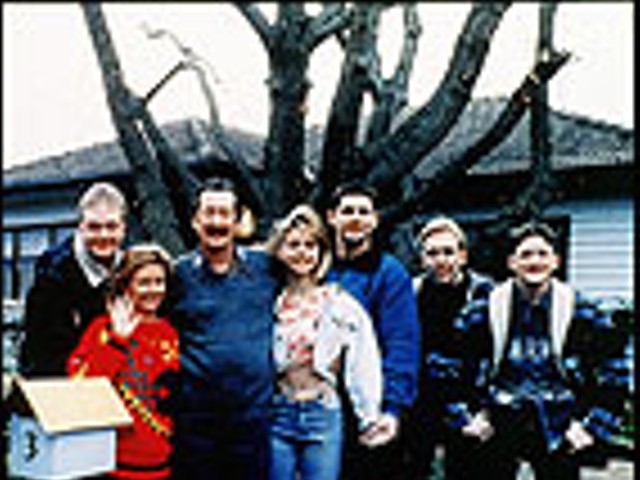With the year 2000 looming ahead, the temptation to compile "best of the century" lists is hard to resist, and Comics Journal (Issue No. 210) succumbs, offering its list of the "Top 100 Comics of the Century."
The Journal is the only magazine in stores willing to consider comics as a serious art form. It generally ignores the mainstream — read: superheroes — and has earned a reputation for rigorous critical examination of comics, exhaustive interviews with the medium’s innovators and, well, snootiness.
Executive editor Tom Spurgeon says the Journal strives "to publish the best writing on comics we can find ... and anyone who tells you different is a drunken twit." Any "best of" list from the Journal is bound to be authoritative, controversial and unashamedly subjective.
"This list is a call for an uncompromising re-examination of the comics medium," Spurgeon says in this issue’s introduction. "It is our hope that in viewing the achievements of the comics art form across a century, comics readers will see the medium in a new light."
So how do you make the cut — what makes for great comics? Great art helps, but a comic’s art must serve the story — and flashy, eye-catching art, or an inappropriate style of art, can compromise content. Strong writing is vital, but flowery, descriptive prose, or just plain too many words, reduces a comic to a mere story with pictures.
At their most basic, comics must seamlessly meld art and writing into a new form that would be diminished by the subtraction of either. Telling a story this way presents special challenges: From complex graphic novels to the simplest newspaper strips, great comics require the rhythm and precision of poetry, the stage direction and "acting" of film, the understanding of the human condition found in prose, as well as technical art and writing skill.
This all sounds pretty lofty when applied to the new issue of X-Men or last Sunday’s "Garfield"; but when the strengths of comics are brought to bear on worthy subject matter — surviving the Holocaust, waiting for the Great Pumpkin, etc. — by a virtuoso creator, the result can be as compelling as any film or book.
Casual comics readers may be surprised by the absence from the Journal’s list of many well-known strips and characters. Spiderman (No. 35) is here, but Superman and Batman aren’t. "Far Side" is passed over in favor of its superior predecessors, Charles Addams’ wicked New Yorker cartoons (No. 58) and the works of master of creepiness Edward Gorey (No. 43). And alongside the rich, melancholy and much funnier world of the urban working guy in Ben Katchor’s strip, "Julius Knipl, Real Estate Photographer" (No. 56), "Dilbert" pales to transparency.
Underground granddaddy R. Crumb makes the list twice, but not with the dope-smoking ’60s characters such as Mr. Natural and Fritz the Cat for which he’s famous. Crumb’s voluminous sketchbook diaries come in at No. 19, and his scathingly satirical work in the ’80s anthology Weirdo makes No. 10. Similarly, it’s the 1950s comic book version of Mad (No. 8), under master humorist Harvey Kurtzman, that the list celebrates, not the current magazine incarnation. And Popeye, known from animated shorts for his amiable pipe-tooting and spinach-gobbling, is here remembered for his more raucous, violent escapades in the ’30s comic strip "Thimble Theater" (No. 11).
Alternative comics, always most willing to push the creative envelope, are well represented. The Hernandez Brothers, producers of the influential comic book Love and Rockets, have five entries on the list, four of them in the top 25. Jaime Hernandez’s work revolves around the tangled lives and loves of the young denizens of an LA barrio; brother Gilbert spins often-tragic and mystical tales of the strong-willed citizens of a fictional Central American town.
Eightball creator Dan Clowes appears for his Nabokovian "Caricature" (No. 82) and for his graphic novel Ghost World (No. 42), about the awkward and painful coming of age of two smart-aleck California girls. Joe Sacco’s journalistic yet very personal Palestine (No. 27) follows the author’s tense travels in the Middle East. Of course, Art Spiegelman’s Pulitzer Prize-winning Holocaust memoir, Maus (No. 4), appears, as does the seminal new-wave anthology Raw (No. 16) that he co-edited.
There are pleasant surprises as well. Carol Tyler’s The Hannah Story (No. 97), about the accidental death of the author’s baby sister, is justifiably praised as the "most beautiful of the ’90s ‘autobiographical’ comics." Howard Cruse’s Stuck Rubber Baby (No. 86), a tale of the Southern civil rights movement seen through the eyes of a white gay man, is called a "classic."
Topping the list at No. 1 is George Herriman’s surreal masterpiece, "Krazy Kat." This highly influential newspaper strip is as famous for its hallucinatory, quasi-Arizonan backgrounds and Krazy’s fractured, vaguely Eastern European speech as for its bizarre love triangle of the gender-ambiguous Kat, brick-heaving Ignatz Mouse and long-suffering Offissa Pupp.
For the record, two of the Top 100 list’s cartoonists, Ernie Pook’s Comeek’s Lynda Barry (No. 74) and Jules Feiffer (at No. 6 for his weekly strip and No. 50 for his graphic novel Tantrum) can be found every week in the Metro Times.
If some of the entries are debatable, this is nonetheless an intriguing "recommended reading" list for comics newcomers and old-timers alike. Get yourself a copy and start putting some meat on the bones of your personal comics library.
Comics Journal No. 210 can be ordered from Fantagraphics Books by calling 800-657-1100. Their Web site address is www.tcj.com.





